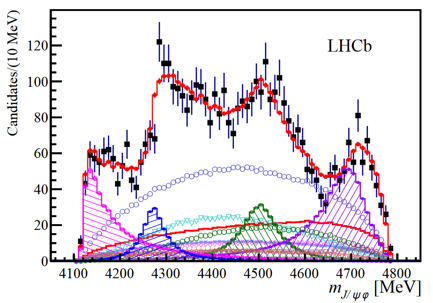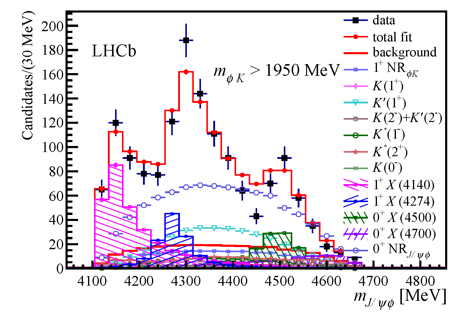Today the LHCb collaboration has submitted for publication two papers (one brief, and the other one containing full details) reporting the observation of four “exotic” particles decaying into a J/ψ and a φ meson, only one of which was well established before. These results were based on a result of a detailed analysis of charged B+ meson decays into J/ψ, φ and K+ mesons using the full run 1 data sample. The data could not be described by a model that contains only ordinary particles, i.e. composite hadrons built of either a quark and an anti-quark, or three quarks. Each of the four particles is observed with a significance exceeding five standard deviations. The sophisticated analysis of the angular distribution of B meson decay products observed with the LHCb detector (a so-called multidimensional full amplitude analysis) allowed LHCb to determine properties (quantum numbers) of the particles with high precision. The images below show the reconstruction of the contributions (in the J/ψφ invariant mass distribution) marked as peaking structures with different colours. The right image shows the spectrum for the selected events with the φK invariant mass to be above 1950 MeV. The properties of these structures are consistent with their interpretation as four-quark particles, which are considered as “exotic”, (hence the “exotic-like” name in the title), although the details of the four quark ccss binding mechanism is still under discussion. The binding mechanism could involve tightly bound tetraquarks or strange charm charged meson pairs Ds Ds* bouncing off each other and rearranging their quark content to emerge as a J/ψφ system (called a “cusp” by experts; note that J/ψφ and DsDs* systems have the same quark content). The high statistics of the LHCb data set and the sophisticated techniques exploited in the analysis will help to shed further light into the production mechanisms of these particles. More information can be found in the first paper, with further details given in the second.
The interest in these four states is also that they are the only known exotic candidates which do not contain u and d quarks, which are the lightest quarks and those which human beings and the matter around us are made of. As such, they may be more tightly bound than other exotic particles.
The observation of the X(4274), X(4500) and X(4700) particles was announced for the first time today. Evidence for the X(4140) near-threshold J/ψφ mass peak at a level of 3.8 standard deviations was first announced by the CDF collaboration and later confirmed by the CMS and D0 collaborations. Searches for this particle by the Belle and BaBar collaborations gave negative results. The LHCb analysis yields a clear observation of the X(4140), and indicates a particle with similar mass but larger width to the earlier measurements from CDF, CMS and D0. It is important to emphasise that simple `bump-hunting’ in the mass spectra is not sufficient to learn about the nature of such complicated hadronic structures. Rather, a multidimensional full amplitude analysis, as described in the two papers submitted today, is crucial for data interpretation, and has allowed LHCb to characterise fully the particles, and to determine their quantum numbers.
These results have been recently presented by LHCb physicists at the Meson 2016 workshop, and at the Rencontres de Blois, FPCP, LHCP and BEACH conferences. The LHCb collaboration has made several other important contributions to the investigation of exotic particles. In February 2013 the quantum numbers of X(3872) were determined. In 24 April 2014 and 9 April 2014 the collaboration published results of measurements which demonstrated that the Z(4430)+ particle is composed of four quarks (ccdu). In July 2015 the first observation of two pentaquark particles, i.e. hadrons composed of five quarks, was announced.
Read more in the CERN Bulletin article in English and French, in the CERN Courier article and also in the Symmetry article.


